Published on January 15, 2013
Bill was a Harvard graduate and a well to do oil man. He knew nothing of airplanes except for what he read in the newspapers with stories of men like Charles Lindbergh who flew the Atlantic to Paris. As the 1920s drew to a close, however, reflecting the increasingly unstable economy, his oil business was suffering. In fact, he was steadily going bankrupt. One day when he returned from a trip, he discovered that one of his oil business partners had taken the liberty of investing $400 of his own money — on his behalf without asking — into a new start-up company called the Taylor Brothers Air Corporation. To explain his reasoning, Bill’s partner simply stated, “Bill, you’re in the airplane business.”
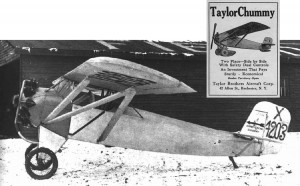
Shortly afterward, with the great crash of 1929, the Great Depression hit. As a result, with no orders for its airplanes, the Taylor Brothers Air Corporation spiraled quickly into bankruptcy and liquidation, overwhelmed by debts. For most, the financial beating of two failing businesses would have been too much. For most, it would have been easier to walk away from the loss. Yet that is not what William T. “Bill” Piper did. Instead, he bought the assets of the bankrupt company for just $761 from the bankruptcy court. His bid was the only one received by the court.
Once established as the sole owner, he rehired the former CEO of the former failed company, C. Gilbert Taylor, recognizing his talent in aircraft design. He appointed Taylor to run the company day-to-day as its new executive director. In the weeks that followed, he ordered a radical shift in the business model — taking the company from the ashes of bankruptcy to become one of America’s greatest civilian airplane manufacturers.
This is the story of Bill Piper and the first years of the Piper Aircraft Company.
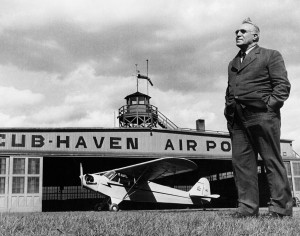
From Rags to Challenges
As the 1930s dawned, the Great Depression was in full swing. Many hundreds of thousands had lost their life’s savings. Businessmen were bankrupted. Wall Street was in a downward spiral. Capital and financing were scarce. Buyers were few. Fear dominated the markets. Unemployment was high. Yet amidst the economic challenges of his time, Bill Piper recognized an opportunity in aviation. He saw clear that despite the challenging economic situation, Americans still craved news reports of pilots and adventure.
The dream of becoming a pilot was the ideal escape from the dreary and dark times that had dawned on America. Aviation was seen as out of reach, even for those who still had jobs and were still making it in the tough economy — after all, the popular wisdom held, very few could hope to fly like Lindbergh.
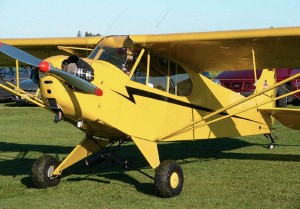
With the end of his oil business, Bill Piper applied his Harvard education and considerable business experience to map out a three-pronged business strategy: a) he would manufacture an airplane cheap enough to buy, priced at just $1,325; b) he would make sure that the design was easy to fly and maintain as well as one that burned little fuel and was reliable; and finally, c) he would train pilots for $1 an hour, even though that was at a loss, because once trained, they would buy his airplanes. With the talented aeronautical engineering expertise of C. Gilbert Taylor, it didn’t take long for the company to begin manufacturing a lightweight, high wing plane that was called the Cub.
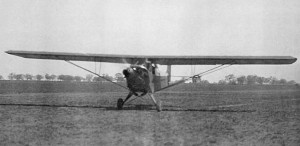
From Cubs to Riches
Initially suffering ups and downs in its business fortunes, the company soldiered through to 1935. At that time, Bill Piper moved the manufacturing and headquarters to Lock Haven, Pennsylvania, and reorganized the company into the Piper Aircraft Corporation. Having built a nationwide network of dealerships, he introduced a new model, the Piper Cub Sport. This newer, advanced model soon became a best seller. In a stroke, his vision had put the company onto a solid footing and made him one of the most successful aviation companies in the world.
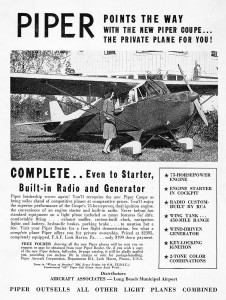
Even then, there were significant challenges ahead. By the late 1930s, Europe was racing toward total war. Nazi Germany was on the rise and threatening its neighbors. It became apparent to Bill Piper that things were about to change once again — sticking to a civilian model would likely result in a severe losses since it seemed likely that civil aviation would be curtailed once war broke out. He reshaped the Piper business model for a possible upcoming period of global war, identifying the US Government as the single largest buyer of his future airplanes.
It wasn’t long before the President of the United States inaugurated a new program on American college campuses, teaching students to fly. First Lady Eleanor Roosevelt herself went aloft in Piper Cub to help promote the program. Soon Piper had airplanes in college flight training clubs across the nation. Concurrently, he introduced the Piper Cub to the US Army, demonstrating it in trials that showed its viability as a tactical artillery spotting aircraft. The Army loved the plane given its reliability, affordability and ease with which pilots could train. As well, he called it the ideal training plane for future combat pilots.
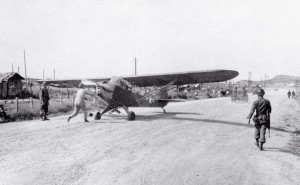
Piper’s Warbird
With the entry of the United States into the war after Pearl Harbor in 1941, Bill Piper’s business plan soon reaped huge rewards. As well, his company was doing great service to the country and war effort. During the three and a half years that followed, the US Army and Navy would procure over 4,000 Piper Cubs, among other designations, it was called the L-4 Grasshopper (and the NE-1 and NE-2 by the US Navy). Over 80 percent of US Army Air Corps (and later US Army Air Forces) pilots trained on Piper Cubs before graduating to more powerful planes. Serving with front line units, the Cub performed a variety of roles, from casualty evacuation to spotting, reconnaissance, executive transport, light cargo missions, resupply, glider training, communications and more. It was used extensively in both Europe and the Pacific.
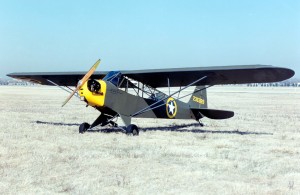
In combat, the Piper Grasshopper proved itself an extraordinary asset. The first combat mission took place in November 1942 when three Cubs took off from the decks of an aircraft carrier and made a flight into North Africa during Operation Torch. The little planes helped reconnoiter enemy positions across Northern Africa and then later flew with the advance up through Italy as the US Army and British rolled north. They flew the beaches on D-Day for the US Navy, targeting naval gunnery missions from overhead. For the Army deeper in Normandy, they spotted enemy positions and, when other air power was unavailable, the pilots took to addressing the problem first hand, firing rifles and more from their small planes.
Afterward and Final Thoughts
With the end of World War II, the Piper Aircraft Company looked ahead to a renewed civilian aviation market. Instead, the market turned out to be softer than expected. Most veterans, including many pilots, instead concentrated on just getting jobs, building families and rebuilding lives in the new post-war economic boom. The Piper Aircraft Company innovated yet again, developing a series of new aircraft, many of which remain the world’s most popular civilian models — the Cherokee, Apache, Warrior, Aztec, Seneca, Seminole, Comanche and others.
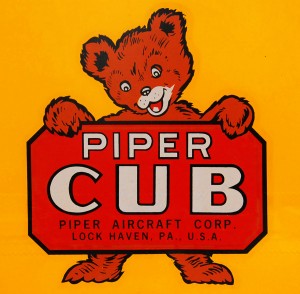
Nonetheless, it would be the Cub — and its later model, the Super Cub — that would prove to be the company’s greatest, iconic airplane. Over 20,000 of the older Cubs were built before the Super Cub was even designed. Today, the little yellow Piper Cub and Super Cub remains one of those “Holy Grail” airplanes that every pilot must fly, even if just once, sometime in their career. In that regard, Bill Piper’s dream of an easy to fly, cheap to buy, affordable to fly and reliable airplane remains as valid today as it was then.
On January 15, 1970 — today in aviation history — Bill Piper passed away. The Piper Aircraft Company has had its ups and downs over the years, yet remains an icon in the aviation industry. As for the Piper Cub, it isn’t hard to imagine that 100 years from now, we will still see Piper Cubs at small airfields around the world. By then, they will likely be powered by advanced diesel aviation engines. Or perhaps they will be known as “Electric Cubs”. Or perhaps they will be laser-solar powered — who knows? Above all, they will still be what they always were — Piper Cubs — one of the greatest airplanes in aviation history.

One More Bit of Aviation History
If you would like a “cheap warbird”, think no farther than the Piper L-4 Grasshopper. If you think it was just a small utility plane that didn’t see much combat, think again — the plane probably saw more action than most P-51s. If you don’t believe it, just look to the story of Major Charles “Bazooka Charlie” Carpenter, US Army, who flew a Piper L-4 Grasshopper during the Allied break out from Normandy and beyond into Germany. His little Piper L-4 Grasshopper was officially credited with the destruction of six German Panzer tanks, including two of the famous Tiger I tanks. However, his own tally of 16 enemy tanks destroyed is probably more accurate since many could not be confirmed at the time given his lone wolf tactics.
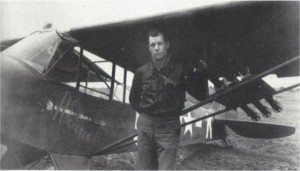
To take the fight to the enemy, he mounted six bazookas, more properly called M-1 Rocket Launchers, on the little plane’s wing struts beside the cockpit (three on each side). These were connected to a set of toggle switches that used battery ignition to fire the rockets. He would fly his Cub, which he named “Rosie the Rocketeer” at higher altitude to spot targets, and then spiral down before pitching over into a steep, head-on dive to attack. When he was close enough to ensure a hit, he would fire off a bazooka round and then pull up to escape away at low altitude between the trees, only to return again shortly after.
As the enemy got wise to his tactics, they began firing at every L-4 Grasshopper they saw. “Bazooka Charlie” amended his tactics and would fly so low that he weaved between trees and popped up over hills to surprise the enemy. His greatest success came on September 20, 1944, when he took off through fog, waited until it lifted and then dove on an advancing enemy tank column during the Battle of Arracourt near Nancy, France. Single-handed, making 16 attack passes over the course of three sorties, he drove the enemy column back and forced the Germans to abandon their objective — not a bad day’s work for one man in a Piper Cub.
Today’s Aviation Trivia Question
How many Piper Cubs were delivered to England for service with the RAF, what was their purpose and what were they called?
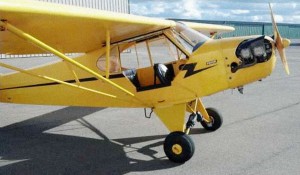
Want your own Warbird Cub?
They usually go for between $29,000 and $45,000 for a good one at Trade-A-Plane. Take a look yourself — click here.
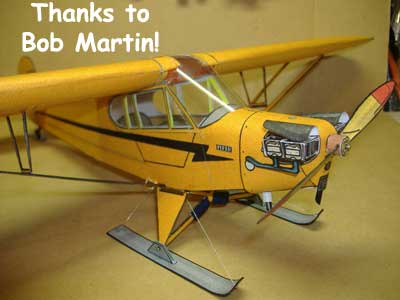
Or Build One as a Paper Model!
If you can’t afford your own Piper Cub, why not at least build one in paper as a desk model — we highly suggest these wonderful paper models designed by Fiddersgreen.com — click here for the Piper L-4 Grasshopper! Or click here for a bright yellow J-3 Cub!
If you build one, send us a photo and we’ll post it here — of course, the usual caveats apply, in other words, be careful when you add that extra bit of nose art!

I have been a member of the fantastic ‘FIDDLER’S GREEN’ for several years now. They directed me to your excellent site today and I have just read the amazing story of the Piper Aviation Co.
I served my apprenticeship with Folland Aircraft, mainly on the Gnat. I emigrated to America in 1963 and joined Piasecki Aircraft Corp in Philadelphia. I had not realised that the Piper Co. was in Pennsylvania. Coincidentally, January 15th is my wife’s and my birthday, the date that Bill Piper died. We also had to return to England in April 1970.
My wife and I are now 76 with a large family, two of whom were born in America. A few years ago, I had the great privelage of meeting Jimmy Stewart. I also felt very humble at meeting Jackie (Sourir) Mogridge, a former ATA pilot and Squadron Leader ‘Jimmy’ James, one of the survivors of ‘THE GREAT ESCAPE’. They all told me of some fascinating experiences.
If interested, to be told these, please contact my via e-mail.